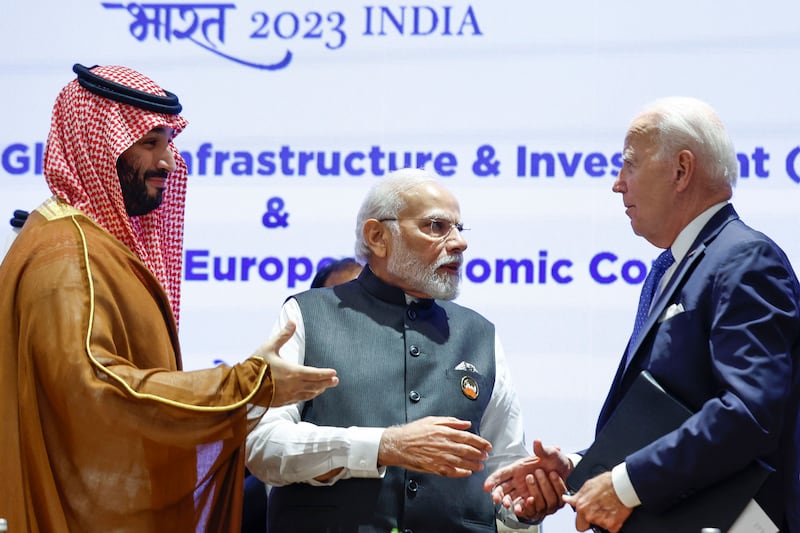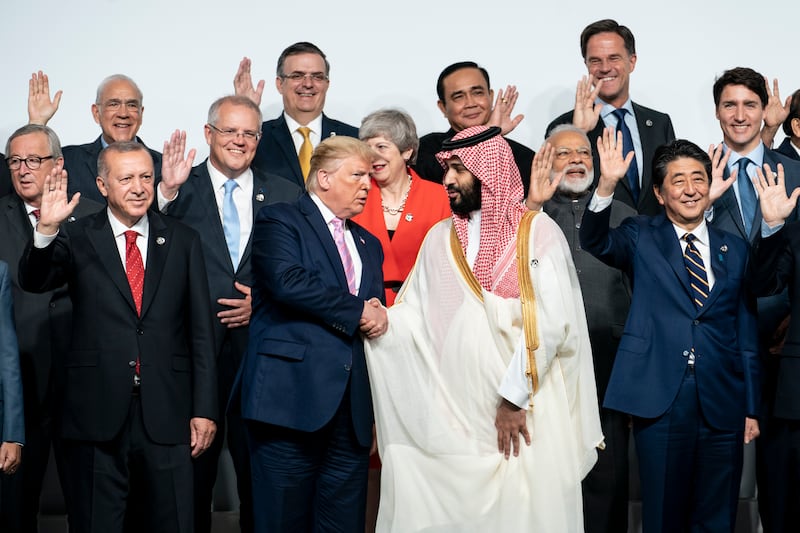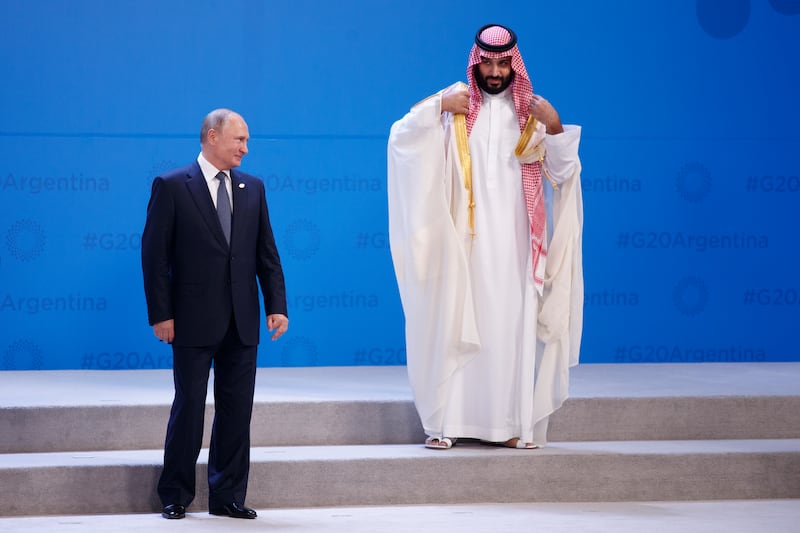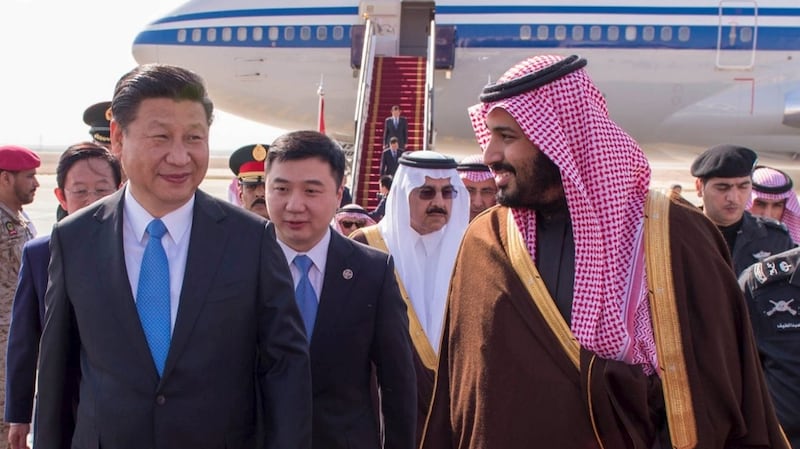“There will be consequences.”
It was the warning a fuming Joe Biden hurled at Saudi Arabia during a CNN interview in the autumn of 2022, a week after the kingdom announced deep cuts to its oil production.
The US president feared the move risked pushing up crude prices amid the turmoil triggered by Russia’s war in Ukraine. American officials, blindsided by the Saudi decision, considered it a slap in the face to an administration concerned about domestic fuel prices in the run-up to midterm elections.
For Biden it was personal. The production cut announced by Opec+, the Saudi-led oil cartel, came just three months after he had expended significant political capital by travelling to the kingdom for talks with Crown Prince Mohammed bin Salman, whom the president had previously refused to engage with.
RM Block
Behind the scenes, harsh words were exchanged. Some in the administration thought the Saudis, who insisted their decision had been based on market dynamics, had deliberately screwed them. It became a make-or-break moment after months of efforts to repair ties between the two. Biden threatened another “review” of the relationship.
Yet the “consequences” Biden threatened never materialised and what could have been a rupture instead became merely a setback in attempts by both sides to rebuild the relationship.
In the months since, relations between the US and Saudi Arabia have blossomed, with the kingdom transitioning from pariah to what administration officials describe as one of Washington’s most important global partners.
US officials note with irony that today it is Israel, not Saudi Arabia, that is standing in the way of a historic deal that would reshape the Middle East: the normalisation of diplomatic relations between the kingdom and the Jewish state.
Such a rapprochement – while impossible as the Israel-Hamas war continues – would deliver Biden a signature foreign policy achievement and Prince Mohammed his long cherished US-Saudi defence pact. US officials believe it could be a key part of a sustainable resolution to the crisis in Gaza. “One thing that is sure to keep a pathway to [a two-state solution] alive is the influence of Saudi Arabia,” says a senior Biden administration official. “It is the one thing that really, truly moves the Israelis.”

In part, the dramatic shift in tone is a reflection of how Biden’s foreign policy has been driven by events rather than ideology, just as Barack Obama’s was before him. The volatile Middle East perennially sucks in US presidents even as they seek to pivot away from the region, a factor brought into sharper focus after Hamas’s October 7th attack ignited the group’s war with Israel.
It also underlines the importance to American domestic politics of energy from the Gulf; although the US has reduced its dependence on oil imports, what happens in the Middle East still affects global prices.
But at its core was a realpolitik realisation in Washington that in the game of great-power competition, Saudi Arabia was too important to ignore, with concerns that if the administration did not engage with Riyadh, a traditional US ally would fall deeper into the orbit of China and Russia.
“How do you keep Russia from aligning with Saudi Arabia? You have to have a relationship [with the Saudis]; how do you keep China from aligning with Saudi Arabia? You have a relationship,” says Jon Alterman at the Center for Strategic and International Studies.
“Part of the argument, [for the rapprochement], is they couldn’t abandon the Middle East to China, and the Saudis reminded the administration of the Chinese option at every opportunity they got.”
‘Great ally’
The US-Saudi relationship has been through highs and lows over the decades, but improved significantly after Donald Trump succeeded Obama and pursued a transactional relationship with Riyadh.
The Republican president made his first overseas trip to the kingdom and inked billions in arms deals. “They have been a great ally in our very important fight against Iran,” Trump said in 2018, only weeks after the brutal murder in Turkey of the US-based Saudi journalist Jamal Khashoggi by Saudi agents.

But Biden did a 180-degree turn. He had vowed on the campaign trail to reassess ties with the world’s top oil exporter and promised to make Riyadh “pay the price” for the killing of Khashoggi. Biden also accused the kingdom of “murdering children’' in an apparent reference to Saudi Arabia’s war in Yemen.
Once in office, he began to act on his threats. A week after his inauguration, he suspended offensive arms sales to the kingdom. A month later, Biden released a classified intelligence report that concluded that Prince Mohammed, the kingdom’s de facto leader, approved a mission to “capture or kill” Khashoggi. (Riyadh blamed the murder on a “rogue operation”).
In the background, however, lines of communications were kept open. Brett McGurk, the White House’s top Middle East adviser and veteran of previous administrations, made an early trip to the kingdom in a bid to quietly reassure the Saudis that things would improve after a few months.
Riyadh also made moves viewed in Washington as overtures to the new president. Shortly before Biden’s inauguration, Saudi Arabia lifted a more than three-year regional embargo on Qatar, another key US ally, that helped foster a region-wide mood shift towards de-escalation between rival Middle East powers. In February 2021, Riyadh released Loujaine al-Hathoul, a prominent Saudi activist.
But relations were still strained when Biden dispatched his national security adviser Jake Sullivan to the kingdom in September that year.
US officials tentatively discussed the possibility of a meeting between Biden and Prince Mohammed at a G20 gathering in Rome the following month, but those plans were scuppered when the crown prince chose not to attend the summit in person.
In the end it was Vladimir Putin who delivered the key turning point. Russia’s invasion of Ukraine in February 2022 sent energy prices to multiyear highs and US officials feared that Riyadh, which had been co-operating with Moscow on oil production since 2016, might side with the Russian president.

“Great power competition with China and Russia’s invasion of Ukraine understandably changed the Biden administration’s views of Saudi Arabia from a problematic partner to a coveted swing state,” says Karim Sadjadpour, a senior fellow at the Carnegie Endowment.
Many in the administration, including in the state department, were still resistant to stepping up engagement with Prince Mohammed. But those who argued that pragmatism trumped moral outrage won the day.
Biden dispatched McGurk and Amos Hochstein, the White House’s chief energy adviser and one of the few administration figures with a background in the oil and gas industry, to the kingdom in January 2022, weeks before Russian tanks rolled into Ukraine. The pair have visited frequently ever since.
As relations tentatively improved, the Biden administration floated the idea of a grand deal for Saudi Arabia to normalise ties with Israel. The carrot for Riyadh, long irked by what it regards as US unpredictability and a perceived lack of commitment to the Gulf’s security, was a defence treaty similar to the one the US shares with Japan, and co-operation with its nascent civilian nuclear programme.
Discussions also began on a potential Biden trip to the kingdom, despite continued consternation across sections of the administration. The case for supporters of the outreach was helped by Riyadh agreeing in April 2022 to a UN-brokered truce with the Iran-backed Houthi rebels they had been fighting in Yemen.
Biden’s trip to Jeddah eventually took place in July, weeks after Opec+ agreed to a modest increase in crude output, something Washington had pushed for in the hope of containing oil prices.
The optics of the meeting in the Saudi port appeared frosty, with an awkward fist-bump greeting between the ageing president and the millennial prince. But US officials insist it went well, clearing the air on differences and laying the foundations for areas of co-operation.
“The point of the Jeddah visit was to break the ice and allow bureaucracies to engage. Once they started talking there was the sense of possibility,” says Alterman.
But then the furore over Opec+’s October decision to cut output ahead of November midterms erupted, causing some irate members of the administration to suspect that elements within Saudi Arabia wanted the Democrats to lose at the polls.
For months there was negligible contact. Riyadh cold-shouldered Washington and hosted Chinese president Xi Jinping for a summit in December, underlining its burgeoning ties to a country that over the past two decades has become the kingdom’s biggest buyer of oil and its largest trading partner.

But as tempers cooled and oil prices remained relatively stable, vindicating the Saudis and persuading US officials that the decision to cut was based on market dynamics rather than politics, the channels of communication were eventually reopened. “It was a tense moment, heading into an election,” says the senior administration official. “I think it’s fair to say there was a misunderstanding of what [the Saudis] were trying to do.”
Now, says a Saudi official, the relationship is “a hundred times better than it was when this administration came in”.
The point US officials make is that the relationship today is about much more than just oil.
The Biden administration realised that in addition to keeping Saudi Arabia from slipping further into China’s orbit, it needed Riyadh’s co-operation on other objectives, such as ending the war in Yemen and de-escalating tensions with Iran. Petrodollars have also influenced attitudes; Saudi Arabia’s Public Investment Fund invested more than $100 billion (€93 billion) in the US between 2017 and 2023.
“The fundamentals are not just the historic defence relationship ... [Saudi Arabia] is a G20 country that wants to work with us on a huge [range of issues],” says another senior US official.
The Saudis, like others in the Gulf, have hedged their relationships with a range of countries over the past decade as the US was perceived to be disengaging from the region. But there is a recognition that neither China nor Russia could replicate the US’s security or diplomatic role in the region.
“The Saudis always realised the US is critical,” says Ali Shihabi, a Saudi commentator close to the royal court. “But the problem has been the US has not been reliable and Saudi Arabia becomes a pawn in US domestic politics.”
Relations with Israel
For both the US and Saudi Arabia, the crowning achievement of this revitalised relationship would be the normalisation deal with Israel that both sides have been working towards.
In exchange for the US defence pact and nuclear co-operation, Saudi Arabia would establish formal diplomatic relations with Israel. The Israelis would have to offer progress towards an independent Palestinian state.
Yet the war in Gaza threatened to scupper the talks. Before Hamas’s October 7th attack, US secretary of state Antony Blinken was scheduled to fly to Saudi Arabia to discuss the Palestinian element of the deal. But when Blinken met Prince Mohammed in Riyadh on October 14th, it was the war that dominated.

Days later, Biden held his first phone call with the crown prince, during which the leaders “affirmed the importance of working towards a sustainable peace between Israelis and Palestinians as soon as the crisis subsides”, according to the White House read out. They also agreed to build “on the work that was already under way” between Saudi Arabia and the US.
That was a nod to keeping the normalisation talks on the table.
Saudi officials privately made it clear they were still open to a deal, but also that Hamas’s attack and Israel’s retaliatory offensive in Gaza had massively changed the dynamics.
While no fan of the Islamist militant group, Riyadh was enraged by the devastation wrought by Israel’s offensive in Gaza. It also realised that for any deal to be politically viable, it would need far greater Israeli concessions on movement towards a Palestinian state than it had previously envisaged.
Sullivan, Blinken, McGurk and Hochstein have all made multiple trips to the kingdom in the months since, discussing the regional crisis and the US-Saudi elements of the deal. But Israeli prime minister Binyamin Netanyahu rejects any moves towards a Palestinian state.
Even in the absence of an agreement, both Saudi and US officials are convinced the reinvigorated relationship can survive. The regional crisis has reinforced the value of the partnership to both; the US has let Saudi Arabia know it is prepared to resume arms sales, while the kingdom allowed the US and its allies to use its airspace in defending against missile and drone attacks by Iran in April.
“The process of working through all of this with Saudi Arabia has, if anything, further clarified our shared interests in the region broadly,” says the first senior administration official. “I think the progress we made is likely to endure.”
Yet for all the apparent bonhomie, the extent of Prince Mohammed’s rehabilitation in Washington remains open to debate.
China remains a key Saudi partner and Prince Mohammed has not dropped Putin, as he seeks to balance relations between the West and East. There are still those in the US who are opposed to closer ties between the US and the kingdom.
The isolationists in Washington “argue that Saudi Arabia is a diminishing power, that betting on oil is crazy and we should be cutting them loose, not bringing them closer”, Alterman says. “And there are also those on the left who say this is a repressive regime we should have nothing to do with.”
But US officials believe Riyadh has moved more into line with the US, particularly in regards to the war in Ukraine. “It’s not that they’re walking away from their relationship with China, but it’s clear, they’re increasingly emphasising the relationship with us,” said Dennis Ross, a former Middle East negotiator now at the Washington Institute.
Alterman says the Israel-Hamas war has also helped shape Saudi thinking.
“For all the governments in the Middle East that said the US is on the way out the door and we have to boost our relations with China, after October 7th we’ve seen all the diplomacy around the US, and none that’s meaningful around China,” he says.
But some say the kingdom’s own diplomatic efforts have also shifted the narrative in Washington away from lingering concerns about human rights abuses.
“Saudi Arabia has very successfully changed the channel,” says Firas Maksad at the Middle East Institute, a Washington-based think tank. “In Washington, it’s no longer about human rights, Khashoggi and Yemen, now it’s all about the possibilities of normalisation and the business opportunities in the kingdom.” – Copyright The Financial Times Limited 2024
- Sign up for push alerts and have the best news, analysis and comment delivered directly to your phone
- Find The Irish Times on WhatsApp and stay up to date
- Our In The News podcast is now published daily – Find the latest episode here





















